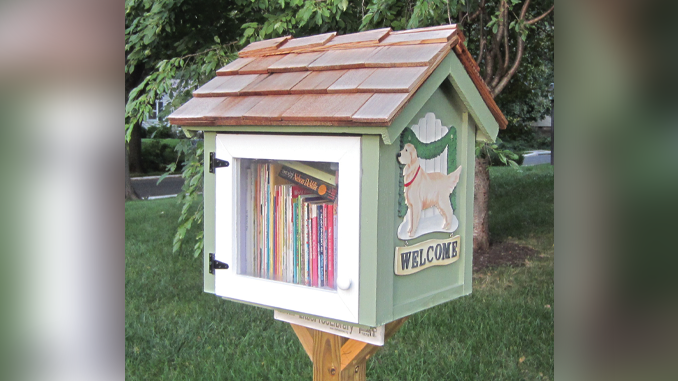My family loves to read. And we love sharing great books with others and discovering new reads. So when I heard about the Little Free Library movement, I knew we had to get involved. These small book-filled structures situated along neighborhood sidewalks encourage passers-by to take home any book they fancy and invite them to participate by donating books in return if they wish. In our case though, we didn’t only want to visit a Little Free Library – we wanted to host one. If you would like to do the same, then read on!
Little libraries come in all shapes and sizes. You could put out a plastic container of books with a sign inviting people to take a book. Or, if you have basic construction skills or know someone who does, you could build a wooden library. Just follow these eleven steps.

What type of roof will your library have? Will the peak face the front or the side? Double door or single? One shelf or two? Do you want to make it in the shape of your favorite object? How much of an overhang will you leave on your roof?
This may sound like a lot to consider for such a simple building. However, it all makes a difference when it comes down to construction. Once you have made those decisions, you will want to plot out measurements for each piece of your library – floor, sides, door, window, back, roof. A common finished size for Little Free Libraries is 20” wide x 18” to 28” tall x 12” to 15” deep.
Gather materials.
You will need:
• 5/8” plywood for the structure itself
• 4” x 4” post for mounting it on
• nails or screws
• wood glue
• caulk
• exterior-grade paint
• hinges
• door handle
• acrylic sheet for a window in the door
• hook and eye to latch door closed
Some library stewards aim for an environment-friendly creation by salvaging construction supplies from what they already have.
Cut and sand the wood.
Measure and mark the dimensions of each piece. Then, using a circular or table saw, cut the pieces to size. For the front of your library, you will also need to mark the opening for your door and cut it out. Then, in the piece you removed, you will want to cut the opening for your window. For the window itself, cut a piece of acrylic one inch larger than your opening (to overlap ½” on all sides). If you don’t own a saw and can’t borrow one, bring your measurements when you purchase the wood. Many lumber and big box stores will cut to order for free or a nominal fee. Once your wood is cut, sand it. Start with a rough grade of sandpaper and sand each piece, making passes with increasingly finer grits. Your patrons will appreciate not having their clothing catch on a rough door or splinters in their fingers as they pull a book out.
Paint the library.
Before you assemble your building, mark which side of each piece will face inside. Paint those first rather than awkwardly reaching inside a finished library. When the paint has dried, flip the pieces over and paint the outside, unless you are painting a special design on the exterior, in which case you should assemble your library before painting the rest. Get kids involved in the painting process – they’ll love helping with this step!
Assemble your library.
Position the sides of your library at the edge of the floor piece, painted sides facing in. Drill pilot holes before nailing or screwing them together. Do this for both sides and back. Then place the front piece with cutout in position and fasten as you did the others. For added stability, you can run a line of wood glue along the edge of each board before fastening.

Attach the acrylic sheet to the backside of the door: center the acrylic atop the door interior, insert short screws with washers snug against the edges of the window so that the heads overlap the acrylic to hold it in place. Fasten the hinges on the door, ensuring it hangs plumb as you do so. Then attach the handle and hook and eye.
Caulk the interior.
Run a bead of caulk along all the corners where the sides of your building meet. You may want to leave the edges where the walls meet the floor untouched. In the event that moisture enters your library, it will have a place to escape.
Attach the roof.
Match your roof pieces at the peak, measuring for an even overhang on all sides. Clamp in place and fasten as you did the sides. Then caulk inside along all roof and wall joints.
Insert your
library post.
Dig a posthole approximately two feet deep. Drop in your post. Using a level to position the post upright in all directions, fill halfway with crushed stone followed by sand, tamping down between layers. To make it even sturdier, mix and pour concrete around the base.
Mount your library to the post.
You could add two angle braces (like those used on mailboxes) for extra support.
Host your grand opening!
Fill library with books, leaving space for visitors to add their own contributions. Attach a Little Free Library charter sign (obtained through littlefreelibrary.org), if you have one. Then invite your friends and neighbors for an unveiling party!
Serving as Little Free Library stewards (as owners are called) can be satisfying for kids and adults alike – watching cars pause in the street to look at your building, receiving messages from friends about the books from your library their kids are reading, venturing out to see what new books have appeared and which ones have been claimed. The few hours of work that go into building one pay off many times over in community interactions and promoting literacy.








